Science : Term 1 Unit 6 : Health and Hygiene
Evaluation
I. Choose the appropriate answer.
1. Ravi has sound mind and physically fit body. Which refers to
a. Hygiene
b. Health
c. Cleanliness
d. wealth
Answer : b. Health
2. Sleep is not only good for body, but it is also good for
a. Enjoyment
b. Relaxation
c. Mind
d. Environment
Answer : c. Mind
3. Our living place should be
a. Openb.
b. Closed
c. Cleand.
d. Unclean / Untidy
Answer : c. Clean
4. The tobacco chewing causes
a. Anamia
b. Periodontitis
c. Tuberculosis
d. Pneumonia
Answer : b. Periodontitis
5. The first aid is to
a. To save money
b. To prevent scars
c. To prevent the medical care
d. To relieve the pain
Answer : d. To relieve the pain
II. Fill in the Blanks.
1. A group of people living together in a particular area is called community
2. I am green colour box with garbage. Who am I ? Domestic waste / Bio-degradable waste dust bin (container)
3. Eyes are considered as windows to the world.
4. The hair follicles produce oil which keeps the hair smooth.
5. Tuberculosis is caused by the bacterium Mycobacterium tuberculae.
III. True or False – If false give the correct statement.
1. All food should be covered. [True]
2. Chicken pox also known as Leucoderma. [False]
Chicken pox is also known as Varicella.
3. Stomach ul cer is a non- communicable disease. [True]
4. Rabies is a fatal disease. [True]
5. First – degree burns damage the whole skin. [False]
First degree bums affects only the outer layer (epidermis) of the skin.
IV. Match the following:
1.Rabie – Salmonella
2. Cholera – Yellow Urine
3. Tuberculosis – Cramps in legs
4. Hepatitis – Hydrophobia
5. Typhoid – Mycobacterium
Answer :
1. Rabies – Hydrophobia
2. Cholera – Cramps in legs
3. Tuberculosis –Mycobacterium
4. Hepatitis – Yellow Urine
5. Typhoid – Salmonella
V. Analogy.
1. First degree burn: epidermis :: second degree burn: layer beneath epidermis (dermis)
2. Typhoid : Bacteria :: Hepatitis : Virus
3. Tuberculosis : air :: Cholera : Water
VI. Choose the correct alternative from the following.
1. Assertion (A) : Oral hygiene is good.
Reason (R) : Sound teeth and healthy gums with healthy surrounding tissues.
a. Both A and R are true
b. Both A and R are false
c. A is true but R is false.
d. A is false but R is true.
Answer : 1) a) Both A and R are true
2. Assertion (A) : Chicken pox is a viral communicable disease.
Reason (R) : Characterized by rashes on the whole body, fever, head ache and tiredness.
a. Both A and R are true
b. Both A and R are false
c. A is true but R is false.
d. A is false but R is true.
Answer : 2) a) Both A and R are true
VII. Very Short Answer.
1. What is hygiene?
Hygiene is defined as good habits, activities that are done for improving and maintaining good health and sound minds.
2. Write about the right way of protect the eyes?
1) Use sunglasses when you go out in the sun.
2) Wash your hands and keep them clean.
3) Don’t rub your eyes with hands.
4) Our food should contain vitamin A. We should eat carrot, fish oil and foods rich in anti-oxidants.
5) Drink adequate water.
б) Avoid reading in dazzling light and dim light.
3. How to keep your hair clean and healthy?
The regular hair wash and massage of the scalp will remove the dead cells, excess oil and dust.
Rinsing the hair well with clear water and using good toothed comb for hair dressing is hightly essential for their maintenance.
4. Sobi frequently playing with her mobile. Suggest your ideas to protect his eye from irritation?
i) Eat foods rich in anti-oxidant, vitamins and minerals
ii) Use antibiotics eye drops or ointment-home remedy
iii) Use contact lenses and glasses with filters.
5. Give any two communicable disease, which spreads in your locality during monsoon?
Typhoid, Cholera
6. What first aid will you provide in the case of bruises?
The trapped blood in a broken blood vessel when blown causes bruises. Apply ice to the bruise area. If there is a swelling, compress by bandage, elevate the injured area.
7. Ravi said “Ganga had minor burn, so I washed with water” Do you agree with his statement or not? Explain Why?
In case of minor bums, the affected area should be washed with cold water and an antiseptic cream should be applied.
VIII. Short Answer.
1. Why the first aid is essential?
First aid is the immediate treatment given to the victim of trauma or sudden illness before medical help is made available. The first aid is essential because it provides a medical care available at the earliest.
2. What this picture Explains?

It points out that we should not litter the place.
3. Distinguish between the following pairs Communicable diseases and Non-communicable diseases
Communicable diseases are those that spread from one person to another. Healthy person must be protected from people with communicable diseases. Diseases spread through contaminated air, water, food or vectors (insects and other animals).
Non-communicable diseases are those that do not spread from person to person. They are caused by other factors. They are never caused by germs, bacteria or other living organisms that infect the body. Antibiotics or medicines that fight against germs do not help to cure non- communicable diseases.
4. What steps you will follow to keep the Teeth healthy?
Brushing two times a day will prevent the formation of tartar and plaque on the teeth and gums.
Flossing will remove food particles plaque and bacteria which build up between the teeth. If bleeding persists it should be treated with proper medical guidance.
We should eat citrus fruits and balanced diet.
Chewing type of tobacco should be avoided.
5. Name the mode of transmission of communicable disease.
Communicable diseases spread through contaminated air, water, food or vectors (insects and other animals).
6. The hair is thin, spares and lost very often. Suggested your ideas to reduce this problem?
Thin, sparse hair and the loss of hair indicates a poor nutritional status. To rectify this problem, one should eat healthy nutritional, balanced diet.
IX. Answer in detail.
1. Write about any three Communicable diseases in details.
Communicable diseases are those that spread from one person to another.
Tuberculosis: It is caused by mycobacterium tuberculae and spreads from one person to another person through air. It spreads by spitting and prolonged contact with sharing materials of the patient. The symptoms are fever, weight loss, chronic cough, bloody spitting and difficulty in breathing.
Prevention and treatment :
❖ BCG vaccination
❖ Giving special attention to the patient
❖ Regular medication
Cholera : Cholera is caused by vibrio cholera and spread through the consumption of contaminated food or water. The symptoms of cholera are vomitting, severe diarrhoea and cramps in legs.
Prevention and treatment :
❖ Good hygiene practices like washing hands before eating.
❖ Avoid eating uncovered food from street vendors.
❖ Drinking boiled water
❖ Getting vaccination against cholera
Typhoid : Typhoid is caused by salmonella typhi and spreads by contaminated food and water.
The symptoms are anorexia, headache, rashes oh abdomen, dysentry and high fever upto 104°C.
Prevention and treatment :
❖ Drinking boiled clean water
❖ Proper disposal of sewage
❖ Vaccination
2. List the situations in which first aid is given. What would you do if a person suffers from skin burns?
First aid is the immediate treatment given to the victim of trauma or sudden illness before medical help is available. It is used
❖ To save the life
❖ To prevent further bleeding determine condition of patient
❖ To relieve the pain
❖ To provide medical care available at earliest
Skin burns affects in three ways
1) First degree burns affect the outer layer (epidermis) of the skin.
2) Second degree burns damage the epidermis and the layer beneath (dermis)
3) Third degree burns involve damage or complete destructions of the skin to its full depth and damage to the underlying tissues.
3. How the disease are transmitted from one person to the other person?
Communicable disease : These are diseases that spread through contaminated air, water, food or vectors (insect and other animals).
They are caused by bacteria and they spread through air, water and some other organisms also.
Tuberculosis – This disease spreads through air. It also spreads by spitting by the infected person. Prolonged contact with the patient may spread the disease to others.
Cholera – through the consumption of contaminated food or water.
Typhoid – by contaminated food and water.
Diseases caused by virus are :
Hepatitis – contaminated water, sharing of needles and blood transfusion.
Chiken pox – spreads through air and contact with the infected person.
Rabies – is transmitted by the bite of the infected dog, rabbit, monkey, cat etc. The virus present in the saliva of dog enters the brain, (via : neurons).
X. Higher order thinking question.
A person is sleeping during day time. Why does this happen with some people that they feel sleepy during day time in office or in the classroom. Have you ever come across such situation? Explain.
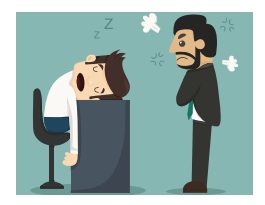
1. When one works for a long time at night without sleeping or watches TV for a long time he falls asleep during day.
2. When the body is tired or exhausted he becomes very weak and sleeps during daytime.
3. When a time-schedule is not followed in one’s routine like eating at fixed time, working and going to bed at regular time it causes drowsiness and sleep during daytime.
4. Daytime sleep indicates brain fatigue and lack of energy in the body.
5. Using stimulants like coffee, tea, alcohol and tobacco disturbs sleep at night and causes daytime sleep.
6. To prevent drowsiness during day we should eat, work and go to bed at proper time. Keeping late hours and working for a long time at night should be avoided.
Student Activities
ACTIVITY 1
What is Personal Hygiene?
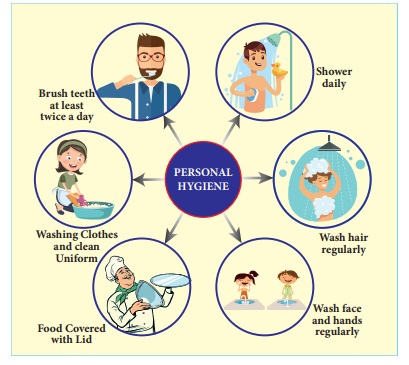
List out your daily activities in the given table

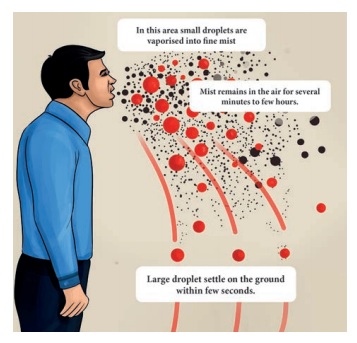
Observe the picture and answer the question.
What will happen, if cold affected friend/ classmate of you, sneezes or cough in front of you?
Small droplets are forced out with germs. These germs fall on your neighbours and cause infection to them.
ACTIVITY 2
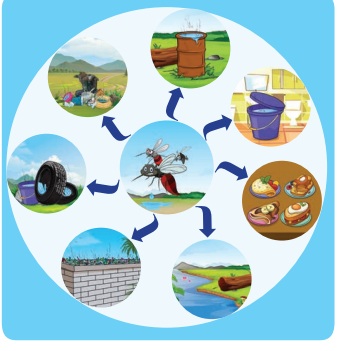
Observe the picture and write remedial measures
1. We should put all garbage only in the garbage bin.
2. The garbage bin should have a lid. It should be properly kept shut.
3. Drainage should be covered. It should not flow into the street.
4. Domestic waste should be segregated into biodegradable and non biodegradable.
5. They should be dropped into the relevant containers.
6. Food stuff should be properly covered. We should not eat anything contaminated by flies.
Dengue is spread by mosquitoes of Aedes aegypti caused by DEN-1, 2 virus belonging tothe type- flavivirus. It decrease counting of the blood platelets of human blood and it has a maximum flight range of 50–100 meters in and around the places.
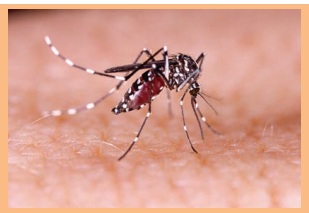
ACTIVITY 3
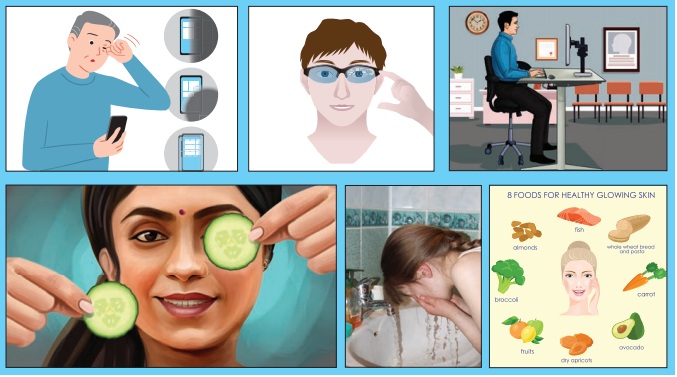
Observe the picture and tick do’s and don’ts in the given tables


In the above checklist what do you understand?
Rubbing the eyes and watching TV or Computer for a long time are harmful to the eye. We should clean our eyes with cold water. For healthy eyes we should eat carrot, orange, lemon and sweet lemon.
Vaccine
A vaccine is abiological preparation that provides active acquired immunity to a particular disease. Vaccines like (BCG,Polio, MMR) are given at early child wood to protect from other diseases.
ACTIVITY 4
Visit nearby Primary Health Centre and collect information about the vaccination given to the children of 0-15 years. Meet a doctor or a health worker in the hospital and enquire about the types of vaccines are available there? disease can be prevented by their usage? Collect the list about the age it should be given?














